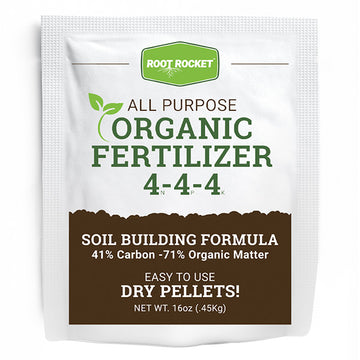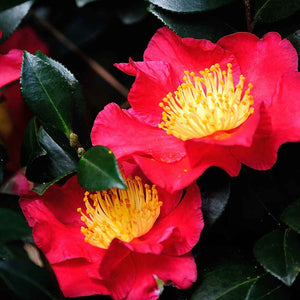Looking for an easy-to-grow shrub for your container garden or patio? Camellias are gorgeous, small to medium-sized evergreen shrubs that flower in the fall and winter. These cold-weather bloomers are unique in that they have the ability to add pops of color to a landscape that often becomes barren and dreary during the winter months. Here are some facts to consider about Camellia sinesis and Camellia japonica:
- Camellias grow well in zones 7 to 10, and a few cold hardy varieties can handle zone 6
- Camellias grow to be 2-12 feet tall and 2-10 feet wide at maturity, depending on the variety you choose.
- Camellias prefer slightly acidic, moist, well-drained soil.
- Camellias are best grown in areas where they can take advantage of having exposure to the morning sun, and partial shade during the heat of the day.
- Camellias are slow growing, but very hardy and long-lived.
- Camellias bloom multiple times per year-in late fall, winter, and early spring.
- They flower in an array of colors from white and pink, to lavender, reds, and yellows.

Why Grow Camellias in Pots
Typically plants are grown in pots to bring beauty to hardscape areas. Additionally, plants are grown in pots to protect them from frost. Pots are easily portable which means they can be moved in and out of direct sunlight or from freezing temperatures to a covered patio.
Landscaping with Camellias
Camellias can be grown in containers of all sizes, and make a beautiful addition to an already existing container garden. Alternatively, these versatile shrubs are perfect as a vibrant entryway piece or on decks. They also make stunning anchors to small gardens and outside structures such as gazebos and garages.
Before planting camellias in pots or in the ground, make sure that you assess your space and choose the variety that will best suit your needs. If you are working with a small space or want to grow them in pots, choose a smaller camellia variety such as the Hot Flash or the October Magic. For larger landscapes or gardens, consider direct planting of larger varieties such as the Kramers Supreme to create a focal point or anchor.
Choosing the Right Size Pot
Once you have chosen your camellia variety, you will need to choose a pot that will accommodate its growth into a mature plant. For most varieties, wide, heavy pots are going to be best. If you are starting from seed or from a very small nursery potted plant, it’s generally best to choose a pot that is at least one size up from what it currently needs. For example, if your small shrub came in a 1-gallon container, you should plant it in a 3-gallon container. If it came in a 3-gallon pot, plant it in a 5-gallon, and so on. Ideally, camellias should be replanted every three years as the soil becomes depleted and compacted. It may also be necessary to replant sooner if the shrub outgrows its container.
Camellia Planting Tips
There are a few things to keep in mind when planting camellias:
- Camellia plants need to be kept moist, but they do not like sitting in water, so be sure to choose a pot or container that has plenty of drainage holes. Adding a layer of mulch will also help drain the soil of excess moisture. If the plant dries out, particularly during the bud development stage, it may result in fewer flowers. For best results, give it about half an inch of water, twice per week. Keep in mind that camellias in pots dry out faster than those grown in the ground. Tip: If you place your finger in the soil and it’s hot and dry, it’s time to water.
- While tap water can be used if no other water is available, the camellia prefers rainwater, which has the perfect amount of natural acidity.
- Consider choosing a north-facing planting location over a southern one, as southern locations may stunt growth and cause the plant to break dormancy too early in the spring. North-facing locations, ideally one with a building, fence, or hedge that serves as a natural windbreak in colder climates will likely serve you best.
- Camellia shrubs thrive in the shade and don’t do well in full sun, especially in hot, dry climates. As a general rule, the hotter your climate, the more shade it will need to thrive.
- When transplanting a potted nursery plant to a container for the first time, it’s best to cut the taproot, as this will encourage your plant to grow wider, more fibrous roots.
- Camellias are heavy feeders and will need both a high-quality potting soil or planting mix, and a nitrogen-rich, slow-release fertilizer applied in early spring, late spring, and mid to late summer. It’s best to avoid using fertilizer after August.
Camellia Plant Care
Camellias are overall a low-maintenance plant. However, here are some tips on caring for these beauties:
- Camellias grown in pots are best replanted every two to three years. As the soil gets depleted, and the plant grows, you will need to take the time to remove the shrub from its existing pot, trim 1-2 inches off the root ball and replant it with a new high-quality potting mix. If the plant has grown substantially, you may also have to change the pot to accommodate the larger size.
- To minimize the chance of bud drop, be sure to prune right after the last flowering. Additionally, be sure to protect your camellia plant from harsh winter temperatures, as frost damage is one of the primary causes of bud drop. To winterize your camellias, water your plant very well shortly before the ground freezes. This will help the plant retain the moisture it needs during the dormant season. You can also add a layer of straw or fall leaves to serve as natural insulation and protect the roots from freezing. In zones 6 and 7, or in any area that experiences cold snaps of 20 degrees or lower, you might consider covering your plant with burlap, canvas, or even a blanket, until your camellia is well-established.
- Fungal diseases such as leaf spot, canker, petal blight, mold, and anthracnose are all common to camellia. If you see signs of these diseases, trim away the infected parts to minimize spread. You can also use fungicides early in the season to minimize risk of such diseases setting in. If you experience problems with pests such as mites, thrips, and aphids, treating them with neem oil will help significantly.
Pruning Camellias
While the camellia plant doesn’t normally need pruning, you might consider pruning camellias in pots to shape them. Camellias do tolerate pruning quite well if it’s done at the right time. For best results, you should always prune and shape your camellia right after flowering is over in late winter, before new growth begins in the spring. Avoid removing young buds during the process, as they actually serve as the blooms for the following year. Look for dead, bare branches, branches that are drooping, and branches or leaves that show signs of blight and other fungal diseases.
Bringing Camellias Inside
If you live in a cooler climate you can move your camellias in pots inside during the winter to a cool area with indirect but natural light. Camellia bushes like humidity. Mist the leaves once or twice daily depending on the humidity level in your home. You can also keep the pot elevated on a saucer lined with rocks and filled with water to add humidity to the air. Just be sure the water line is below your pot so you avoid keeping the soil saturated.
Growing camellias in pots can be fun and rewarding. Your patio, front steps, or wherever you choose to place them will exude elegance and style with colorful blossoms.
Add some spring to your winter with our gorgeous collection of Camellias. Browse camellia varieties at PlantingTree and bring beautiful blossoms of color to your winter landscape.
You May Also Like:



